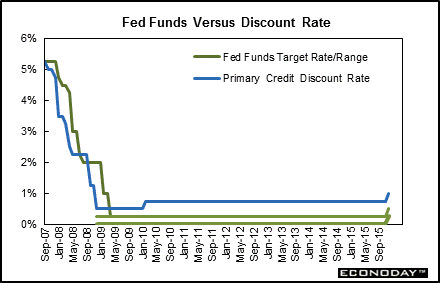
|
Long Term Perspective The Fed's primary policy tool is setting the fed funds target rate. Fed funds are loans that banks make to each other on the open market. These short-term loans help banks that are short on reserves to meet reserve requirements. The Fed directly controls the fed funds rate by how much money the Fed injects or withdraws from the financial system.
The Fed adjusts the fed funds target rate to address recession, inflation, and other economic issues. The Fed cut the fed funds target rate from January 2001 through November 2002 in response to a recession, fears of deflation, and weak economic growth after the end of the 2001 recession. The Fed then began a tightening cycle in June 2004 which ended with a 17th consecutive increase in June 2006. The tightening was intended to preclude unacceptably high inflation. The Fed began an easing cycle in August 2007, cutting its discount rate by 50 basis points followed by multiple cuts in both the fed funds and discount rates. These cuts were intended to preclude recession and to help stabilize financial markets after the break out of the sub-prime crisis in mid-2007. From then to 2015, the Fed kept rates very low, at a range of zero to 0.25 percent for Fed funds target, to help strengthen the sluggish recovery. In December 2015, in an effort to ease any risk of overheating in the labor market and confident in the strength of the economy, the Fed raised the funds target by 25 basis points to a range of 0.25 to 0.50 percent.
A lesser known policy tool is the Fed's discount rate. This is the rate the Fed charges banks for borrowing reserves from the Fed's discount window at regional Federal Reserve Banks. In January 2003, the Fed instituted a primary credit and secondary credit discount rate. Traditionally, the primary credit discount rate is set at 100 basis points over the federal funds target rate, while the secondary credit rate is set at 150 basis points over the funds rate. But over the current easing cycle, the Fed has reduced this gap down to 25 basis points for the primary credit discount rate (above the top of the range for the fed funds target). With a February 2010 increase in the discount rate, the Fed started the process of returning to a normal spread and in December 2015, along with the rise in the funds rate, it hiked the discount rate by 25 basis points to 1.00 percent.
Short Term Perspective Solid strength in nonfarm payroll growth, averaging over 200,000 in late 2015, prompted the Fed to tighten policy, this despite continued weakness in global demand and continued weak readings for key inflation readings including PCE prices. But the domestic economic backdrop was strong as consumer spending along with both residential and business investment were described by the Fed as solid. Overall, however, the Fed's description of the nation's economic health remained no better than "moderate". Inflation continued to be very subdued but the Fed, despite another leg down in oil to under $40, remained confident that overall economic growth, together with a likely leveling in oil and commodity prices, would begin to allow inflation to trend, as it historically has, toward their 2 percent target.
|
||||||||||
| Legal Notices | ©Copyright 1998-2024 Econoday, Inc. |
powered by
![[Econoday]](images/logo.gif)
![[Apple App Store]](/images/AppleAppStore.png) ![[Econoday on Kindle]](/images/kindle.jpg) 
|
|||||||||

